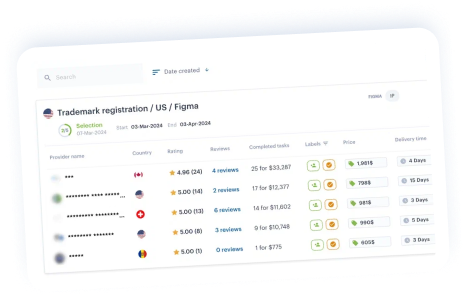By: Venita Yu – Wisely & Mansion Intellectual Property (Hong Kong) Limited, China
It is our pleasure to provide an outline of the trademark registration system in Hong Kong. We hope this will help you grasp a basic concept for the trade mark protection system in this special region.
As an international financial and trading center and one of the prominent cosmopolitan cities in Asia, and being a Special Administrative Region of China, Hong Kong is the window of Mainland China. Under the “one country, two systems” political institution, Hong Kong has an independent trademark system beyond Mainland China. Accordingly, protecting a trademark in Hong Kong is of great importance (also read an article about trademark registration in China)
Contents
1. What can be registered as a trademark in Hong Kong?
2. Why can you be refused to register a trademark in Hong Kong?
3. The process of trademark registration in Hong Kong
4. Documents required for the registration of a trademark in Hong Kong
5. Trademark opposition process in Hong Kong
6. Trademark registration costs in Hong Kong
1. What can be registered as a trademark in Hong Kong?
A sign that distinguishes the goods and services of one trader from those of others could be registered as a trademark. Typically, a trademark can be words (including personal names), indications, designs, letters, characters, numerals, figurative elements, colors, sounds, smells, the shape of the goods or their packaging, or any combination of these. A sign must be capable of being represented graphically to be registered as a trademark.
The classification is based on the International Classification of Goods and Services, and multi-class trademark applications are acceptable in Hong Kong.
2. Why can you be refused to register a trademark in Hong Kong?
A trademark is refused registration for absolute ground and/or relative ground.
For the absolute ground, it is most likely for the below reasons:
- A trademark is devoid of any distinctive character
- A trademark consists exclusively of a sign which may serve, in trade or business, to designate the kind, quality, quantity, intended purpose, value, geographical origin, time of production of goods or rendering of services, or other characteristics of goods or services
- A trademark consists exclusively of signs which have become customary in the current language or in the honest and established practices of the trade.
- A trademark in relation to goods if it consists exclusively of the shape that results from the nature of the goods themselves, the shape of goods that is necessary to obtain a technical result, or the shape that gives substantial value to the goods.
- A trademark is contrary to accepted principles of morality or likely to deceive the public.
- Its use is prohibited in Hong Kong under or by virtue of any law, or the application for registration of the trademark is made in bad faith.
- A trademark consists of or contains the national/regional flag/anthem/emblem or its design;
If the objection is raised for reason of 1 to 3 in the above list, the trademark application may be accepted if the applicant establishes, to the satisfaction of the Registrar, that, before the date of the application for registration, the trademark has in fact acquired a distinctive character as a result of the use made of the mark on the applied for goods/services in Hong Kong. The Registrar would consider the quantity and length of time of the use. There is no fixed period of use, although five years is a useful benchmark.
For the relative ground, it is most likely for the below reasons:
- A trademark is identical/similar to an earlier trademark, and the goods or services for which the application for registration is made are identical/similar to those for which the earlier trademark is protected, and the use of the trademark in relation to those goods or services is likely to cause confusion on the part of the public.
- In case an opposition is raised, a trademark could not be registered if:
- The earlier trademark is entitled to protection under the Paris Convention as a well-known trademark.
- The use of the later trademark without due cause would take unfair advantage of, or be detrimental to, the distinctive character or repute of the earlier trademark.
- By virtue of any rule of law protecting an unregistered trademark or other sign used in the course of trade or business (in particular, by virtue of the law of passing off).
- By virtue of an earlier right, in particular, by virtue of the law of copyright or registered designs.
The honest concurrent use of the trademark and the earlier trademark for a long period of time, or a letter of consent issued by the prior trademark might solve the relative ground objection. If the Registrar believes that the applicant is not using or not intending to use the trademark on the applied for goods/services, an objection might be raised. If the Registrar finds on the internet that the trademark is owned by another party, an objection might be raised.
3. The process of trademark registration in Hong Kong
Procedure: Filing Application – Deficiencies Checking – Substantive Examination – Publication for Opposition (3 months) – Registration
If there are no deficiencies in the application and no objection to the trademark application, the whole application process might take as little as 6 months from receipt of application to registration.
The trademark registration is valid for a period of 10 years from the date of registration and may be renewed every 10 years from the date of expiration of the last registration.
4. Documents required for the registration of a trademark in Hong Kong
For filing a new application, the following information is required:
- The full name and address of the applicant. If the applicant’s name is not in Roman letters or in Chinese, a transliteration in Roman letters, such as XXX KABUSHIKI KAISHA, XXX JOOSIKHOISA, should be provided. The English name could be included in a bracket after the transliteration name, e.g. XX KABUSHIKI KAISHA (XXX Corporation).
- Applicant type, i.e. individual, incorporated or unincorporated. If the applicant is a limited company, the applicant type is incorporated.
- Country/Territory/Area of incorporation. If the applicant is incorporated in the United States, please provide the state of incorporation.
- Clear presentation of the mark (better in JPG format).
- Class(es) and goods or services list:
- On the basis of the Nice Classification.
- As well as the specific items, the Classes headings are also acceptable.
- There is no limitation for the number of items in each class.
- If the priority right is claimed, the Convention priority details, i.e. priority date, priority country and prior application number, should be provided.
It is possible to file a series of trademarks with two to four marks which resemble each other as to their material particulars and differ only as to matters of a non-distinctive character not substantially affecting the identity of the trademark, such as Mark A is a color mark and Mark B is a black and white mark.
5. Trademark opposition process in Hong Kong
First stage: Filing Notice of Opposition by the opponent / Counter Statement by the applicant
- The opponent makes his application by the Notice of Opposition and Grounds of Opposition within 3 months from the publication date or before the extended deadline. The extension is granted only in specific circumstances.
- The applicant files a Counter Statement within 3 months after the date on which he receives a copy of the application and statement of grounds. If the applicant does not file a counter-statement within that time, the application will be withdrawn.
Second Stage: Filing Evidences by each party
- The opponent files evidence by way of statutory declaration or affidavit in support of the grounds stated in his application, within 6 months after the date on which he receives a copy of the counter-statement from the owner.
- The applicant files evidence by way of statutory declaration or affidavit in support of the grounds stated in his application, within 6 months after the date on which he receives evidence from the opponent.
Third Stage: Hearing
- The Registrar shall, on his own initiative, fix a date, time and place for the hearing and give notice of the hearing to the parties. Generally, a hearing may be scheduled over one year.
6. Trademark registration costs in Hong Kong
Official fees of trademark registration in Hong Kong:
| Filing an application | |
| a) for the first class | 2,000 HKD |
| b) for each addition class | 1,000 HKD |
| Renewal of a trademark registration | |
| a) for the first class | 2,670 HKD |
| b) for each addition class | 1,340 HKD |
The trademark registration cost in Hong Kong via the iPNOTE platform starts from as low as $450, which includes all government fees and document preparation. Find the best patent attorney in Hong Kong on iPNOTE.
7. Useful links
-
- Use the Nice Classification to determine the classes and goods you need. Note: in Hong Kong, both the class heading and specific items are acceptable, and there is no limit to the numbers of the item in each class.
- Conduct a Trade Mark search to see what trademarks have already been registered.
- Refer to Trade Marks Ordinance for a detailed process of trademark registration in Hong Kong.
- Check Trade Marks Rule to find rules of trademark registration in Hong Kong.
- Visit the Intellectual Property Department of Hong Kong to find information about IP registration in Hong Kong.
8. Final thoughts
The cost of registration is limited, but the risks of not registering are unlimited. If the Hong Kong market is very important for the products under a brand, registering a trademark could protect the trademark rights regionally. Whether to register a trademark in Hong Kong and how to protect the trademark would depend on the individual needs and different circumstances.
Please note that the trademark practice might change in response to the policy needs. All information should be subject to the Trade Marks Ordinance and the publication of the Intellectual Property Department of Hong Kong.
***
Have questions about trademark registration in Hong Kong? Contact Wisely & Mansion Intellectual Property (Hong Kong) Limited via iPNOTE.
Explore our website for trademark registration and discover our specialized Korean trademark search services.







